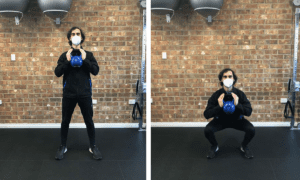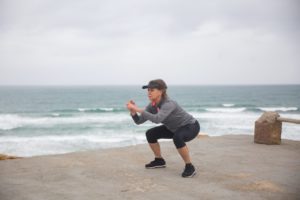Many of us may have heard statements at some point in time like this… ‘Squatting is bad for your knees’ or ‘You are going to do more damage than good’. Let’s dive into this day-old myth.

Squatting is a vital movement that we learn at the same time as we are learning to stand and walk as a young kid. If you look at a child when they pick something up from the ground they will squat down with perfect form. Why shouldn’t we be able to do this throughout our whole life?
So, are squats bad for our knees?
The research actually points towards…No, squats are NOT bad for our knees. A lot of the fear stems from the supposed tension and stress put on the knee when performing the movement. Research has shown this not to be the case as the tension and stress peaks at 90 degrees of knee flexion (bent knee) which is the same degree of knee flexion we achieve when going up a set of stairs.
Benefits of squatting

Squatting is a compound movement, meaning it utilizes multiple muscles. You are getting more bang for your buck. It is also a functional movement that can help in all walks of life whether you are wanting to improve your sporting performance or be able to squat down in the garden or pick up your kids or grandkids.
Our body loves to adapt and just like our muscles, the other structures around the knees such as tendons, ligaments, cartilage, and meniscus can also adapt and become stronger through squatting. As we gradually progress the exercise through increasing load or difficulty these structures get stronger, and we can see improved pain. The other hidden benefit a squat can have is improving mobility and flexibility of your lower body.
In order to get these benefits, it is key to make sure we are doing the movement with proper technique and load management, and that we start out in the right way at a level our body is ready for. Too many people have injured themselves jumping into things too quickly.
What if it hurts when I squat and already have pain in my knees?
This may be due to a number of contributing factors and could mean you might not be ready to squat…YET, but working towards this is an amazing goal to strive for. Completing accessory exercises to increase the strength and mobility through our hips, knees and ankles can be a great way to work towards the goal of being able to do a healthier and happier squat.
Additionally, like any movement that may give you pain it is important to take a graded approach to work within your capacity and gradually progress. As mentioned above, if you are getting pain when squatting, a combination of accessory exercises and a variation of a squat could be the answer to managing that pain.
Busted Squatting Myths
MYTH: Squatting will lead to more wear and tear of my knee.
When squatting, if you are using proper technique, load management and a graded approach this will not lead to more wear and tear and has actually been shown to improve knee health and integrity.
MYTH: You should not squat with your knees over your toes.
This has been a common misconception when it comes to squatting for a long time. It is completely fine to squat with knees over toes as long as your foot is maintained flat on the ground and weight is evenly distributed through that foot there will be no added risk to the movement.
MYTH: Squatting below parallel is a no-no.
Another common misconception. If you are able to and have the mobility to squat below parallel with correct technique this is fine. If your range of movement is restricted, it may be beneficial to complete some mobility exercises to help.
Take away message

For a long time the squat has been blamed for knee pain and avoided by so many of us. However, research has proven otherwise. This functional movement does not have to be painful and with the right modifications and guidance from a professional we can start to see improvements in knee health and pain symptoms with graded exercise which can include squatting.
If you would like to get into squatting or may have a pre-existing injury and do not know where to start it is always a good idea to have an expert opinion from an Accredited Exercise Physiologist.
Author: Tate Marino, Accredited Exercise Physiologist




